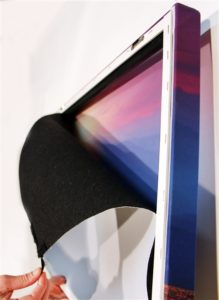What is the textile industry doing for the environment?
2,150 companies (spinning, weaving, and dry filling etc.) represent the textile industry in France, 1,300 of which have fewer than 10 employees. In 2017, it generated a turnover of 13.4 billion euros (up 1.8% on 2016) with 60,350 employees. It uses three types of resources: natural fibres (cotton, wool etc.), man-made fibres (viscose, a wood cellulose derivative produced from a chemical process) and petrol-derived synthetic fibres (polyester, acrylic etc.).
A strong ecological footprint
Like all industries, the textile industry has a number of impacts: climate change, freshwater eutrophication, depletion of mineral and fossil resources, respiratory effects, energy consumption. To this effect, the Ademe identified the phases of the clothing item lifecycle that contribute the most to each of these aspects in a study made public in September 2018*, each phase (raw material production, pre-boarding, transport, use etc.) having specific impacts (e.g.: use of fertiliser for production, dyeing processes, water, electricity and steam consumption and use of detergents etc.).
- In terms of climate change, a report by the Ellen MacArthur Foundation in November 2017 showed that the textile industry emits more CO2 than commercial air and maritime transport together, with 1.2 billiont CO2eq emitted in 2015.
- In terms of chemical substances used, the Detox campaign launched by Greenpeace in 2011 is starting to see effects, at the same time as changes in legislation such as Reach. For example, the committed brandsare working on removing eleven priority substance groups. And 72% of participating brands say they have managed to remove per- and poly-fluorinated substances (PFCs). Also, the Swedish chemical substances agency (KemI) and the French ANSES agency have just prepared a joint proposal for the prohibition of more than one thousand allergenic substances in clothing and footwear in Europe. The proposal was submitted to the ECHA, the European chemicals agency, whichhas six months to examine it.
Towards a textiles circular economy?
In its strategic contract signed in January for 2019-2022, the CSF Mode et Luxe would especially like to create impetus in order to instil a circular economy virtuous dynamic. Severalareas of work have thus begun in traceability, recycling, new materials and sustainable materials. As today, on a global scale, only 1% of fabric is recycled and reused to make new fabric. In France, the EPR sector for clothing textiles, household linen and shoes was set up end 2008 (“Eco-TLC”). According to the eco-organisation, out of 624,000 tons of THS marketed, 223,000 were collected, 184,494 of which were sorted and reusedin the 60 approved sorting centres. 58.5% of the THS sorted is reused and 41.2% recycled and put to energy recovery. It should be recalled that the 2008 Waste Directive which requires at least 50% household waste recycling / reuse for various materials, including textiles, enters into effect on 1 January 2020 and that the Member States will have to set up two additional separate collections, one for textiles, the other for hazardous waste, by 2025.
It is therefore necessary to create a genuine nationwide recycling strategy for the fashion and luxury sector. This involves the development of sophisticated technologies (optical sorting, sorting using robots etc.) which can be used to turn textile waste and leather into resources at an affordable economic cost. It also involves consolidation of qualified source collection and reuse of recycled materials. In short, ecodesign, process optimisation, identification of opportunities and value creation for end of life or unsold items are tending to become the textile sector’s watchwords.
LINEN: A WINNING EUROPEAN ADVANTAGE
“Virtuous” by nature (it protects soils, does not require watering and does not generate waste as the entire plant is used), linen offers promising perspectives. It provides for local farming employing significant, non-transferable labour. Linen is an integral part of the current movement to manage and disseminate the use of biosourced and recyclable textile fibres.
Innovation, the way of salvation

Depolluting fabric based on the natural movement of the air
For a long time considered traditional industry, the textile sector is today giving major room to innovation. Institutes such as the CETI (European Centre for Innovative Textiles) or the IFTH (Institut français du textile et de l’habillement-French textile and clothing institute) or even the competitiveness clusters Techtera, Fibres-Energivie and Up-Tex which are due to merge with Innotex and Matikem next July to form EuraMaterials. Among the innovations, technical textiles occupy first place. They can have fire-protection or anti-UV properties, be self-cleaning, insulating or even conduct electricity. Likewise, textiles are becoming intelligent through the use of opportunities offered by the digital. As part of the “New Industrial France”, the technical and intelligent textiles plan has already selected seven projects, of which Lightex (first factory making ‘smart textiles’ by luminous fibre optics) and Autonotex (energy-independent smart textiles).
Pollutec 2018 was even the occasion to present air movement-based depolluting fabric by the Italian Anemotech. At the same time, the concept of the textile factory of the future is coming together with new dry filling and folding technologies increasingly boosted by digital tools.
TWO REUSE DEMONSTRATORS
The French textile industry is to acquire two demonstrators in view of reusing collected materials. One, mechanical, to process pure cotton items (in the Hauts de France region); the other, chemical, for separating cotton and polyester (in the Auvergne-Rhône Alpes region). The polyester recovered could be used in sports clothing or luggage in particular. So, to be continued.
* Report “Modelling and assessment of environmental impacts from consumer products and capital goods”, Ademe, September 2018.




